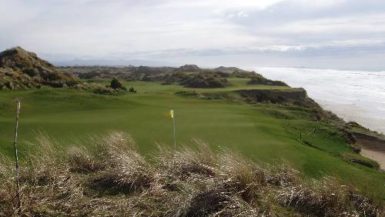PACIFIC DUNES GOLF COURSE
Round Lake Drive
Bandon, OR
888.345.6008
www.bandondunesgolf.com
Architect: Tom Doak
Par 71
Excitement Level – 12/12
Difficulty – 9/12
Conditioning – *****
Cost – $200 peak, $60 reduced
Value – *****
Tees Yards Rating Slope
Tournament 6557 72.9 133
Regular 6174 70.9 131
Resort 5799 69.3 125
Forward 5101 71.1 131
It’s all true. Everything you ever heard, everything you ever read. Every superlative, every rave review, every resounding endorsement, every story of how magnificent the golf courses are, all the tales of the world-class après golf, it’s all true. In fact, words fail to convey just how superlative Bandon, Oregon is as a golfing Mecca. If anyone needs any proof that we are presently experiencing the golden age of golf course design, come straight to Oregon. You will find religion. In fact, since 1999 the golf world has raced to Oregon to play the most celebrated facility to open in decades, maybe even a century. If the true test of a golf course is its popularity with players, Bandon Dunes’ greatest mark of success and reverence is the countless golfers who all return to their respective homes fully convinced that they have experienced a great golf miracle.
Designed in the spirit of Scotland’s and Ireland’s ancient links, Bandon Dunes Golf Resort offers more than 54 holes of the most authentic links golf a player can encounter anywhere in the world. Conceived and executed in harmony with the natural environment on Oregon’s rugged southern coast, these epic courses sit on a beautiful stretch of sand dunes sixty feet above the pounding Pacific surf, framed by the Oregon tall pines. The terrain is as authentic as any linksland in Scotland or Ireland; a blissful panorama of ocean, dunes, forest, and sky in every direction. Spectacular sixty foot dunes covered in gorse, fescue and native vegetation frame the inland holes while the seaside holes play along the clifftop with the Pacific lapping their feet. Greens and tees hang brazenly on precipices. Fairways meander through fragrant gorse and towering dunes on sandy soil. The ever present ocean winds are a factor, sometimes pleasant and refreshing and sometimes overwhelming in their intensity, a true attribute of links golf. While there is onsite lodging, there is not a single house to be seen anywhere on the golf course and never will be so long as Mike Keiser is the owner. Even the clubhouses for the respective courses do not sit anywhere near the ocean. All in all, the site has 23 miles of undisturbed shoreline.
This watershed moment in golf history began with a cold call from a real estate agent from Gold Beach, Oregon, who heard that real estate developer Mike Keiser was looking for coastland area for a golf course. The agent told him about 1200 acres on the coast of Oregon with one mile of oceanfront property. No one could blame Keiser for being skeptical at first. He had been searching all over North America for just the right site. Rural Oregon seemed a remote for an epic golf resort.
Moreover, the region had a long history of being economically depressed. Except for a brief time when the gold rush made the town flourish in the mid-1800’s, Bandon, Oregon was traditionally the site of logging and fishing industries. As these industries declined, tourism had to take its place to help the economic status of the region which was actually known more for Eugene, the nearby hippie and hobo kingdom. Indeed, until 1999, the town of Bandon, Oregon had been little more than a stop on the drive to California where tourists could take in the rugged and spectacular dunes and shoreline. It seemed as though time itself had passed this sleepy corner of the world by. But Keiser saw its potential for what proved to be the greatest story in golf design in a century.
**********************INSERT*************************
The town actually burned to the ground once due to a disastrous fire spread by the flammable gorse which was originally imported to the town. Still burned into the town’s psyche, many actually protested the re-importation of gorse to line the fairways as they exist today.
****************************************************************
The story becomes more incredible when one contemplates the architects responsible for making Bandon Dunes the number one facility in the world. David McKay Kidd, a 27-year old Scot, had never before been responsible for a project of such magnitude. True, Kidd’s father, Jim Kidd, was the superintendent of greens at the Gleneagles Hotel, but that was hardly a pedigree which would lead people to believe that a facility was about to blossom and unseat mighty Pebble Beach from its lofty perch as the greatest golf venue in America, especially from a first time designer. But when the stage was biggest and the stakes were highest, Kidd seized the moment.
**************************INSERT********************
Keiser’s original idea for the design was to have an amateur competition and use the best 18-hole designs for Bandon Dunes.
*********************************************************
The facility first opened the Bandon Dunes layout for play in 1999. Injecting much needed life vibrancy and tourism into the region, the town emerged from a decades long economic slumber. Thousands flocked to experience golf “the way it was meant to be.” Keiser succeeded in turning back time to the days when the game was first created. The course opened to instant world wide acclaim.
But Keiser and company did not rest on their laurels for long. Keiser secured golf writer turned golf architect Tom Doak to build the even more incredible Pacific Dunes course. When Tom Doak announced that he was going to try his hand at designing golf courses, many course architects that he had candidly criticized (perhaps too candidly to them) were licking their chops for a chance at revenge. Doak’s candor in evaluating golf courses was well appreciated by his readers but not by designers, who despite much fame and acclaim, have notoriously thin skins. More than a few people were primed for some payback. The chance for payback never came as Doak talked the talk and then walked the walk.
Doak’s success was no fluke. He was not merely some writer who got roped into writing about architecture by a desperate editor. Doak studied landscape architecture at Cornell University and after graduation received a grant to go and study the great golf courses of the British Isles. He played nearly 200 courses in all. At 23 years of age, he was put in charge of ratings for Golf Magazine, which publishes the most important and accurate golf course ratings in the world. When given the opportunity to put up or shut up, he has delivered masterpieces throughout the country including High Pointe, Legends (Heathland), Beechtree and Apache Stronghold.
Like at its sister course, Doak sought to seamlessly weave the holes onto the tapestry of land. In this regard, Doak was the perfect choice to blend the course harmoniously with its surroundings. Nicklaus would have finished on the cliffs, Dye would have made golfers play up and down the cliffs, Fazio would have moved the cliffs, Silva would have made it look like Seth Raynor was there and put in perpendicular hazards and Strantz – well who knows what he would have done with the cliffs, but it sure would have been interesting!
Most importantly, there is nothing artificial about either Bandon or Pacific Dunes and that’s what makes it all the more incredible. It looks as though it has been there for centuries. At times contemplative, poetic and serene (“pacific,” if you will…) and at times windswept, rugged, and heathen, the setting is unparalleled in America. The courses tantalize all of the senses. The fragrant perfume of the gorse, the rhythmic, lyrical hushed whisper of the ocean waves, the soothing aural backdrop of sea birds and aquatic life, the fresh, cleansing taste of the sea air, the waft of the breeze in the hair, the unforgettable cityscape of sand dunes and the siren like wave of the flagsticks tucked oh so close to the cliff’s edge; Bandon Dunes is a heavenly union of sea, soil and sky.
In an industry filled with superlatives, where every course is seemingly among the greatest on earth, Pacific Dunes deserves that mantle. Some knowledgeable golf experts have even called Pacific Dunes the best course on earth. For an architect who has designed barely ten courses, that is high praise indeed. Many players and writers already favor it over Pebble Beach, not only because it is ½ to 1/5 the cost, but the design is a much more authentic links and a stronger routing. A short five years ago, it would have been heresy (or at least certifiable lunacy) to proclaim any public course to be better than Pebble Beach. Well, the fantasy has become reality, to the inestimable delight of public golfers everywhere.





[…] First, the team here at AWITP will join forces with Tony Korologos of Hooked on Golf and The Golf Space for a three day event at fabled Black Mesa Golf Club, which I reviewed in this piece for Golf Observer. Black Mesa is one of the three most important public courses to open up since Sawgrass opened its grassy guillotine in 1980. For those of you scoring at home, the other two are Bandon Dunes Resort in Oregon and Tobacco Road in the Pinehurst area. […]
[…] who restored the Knoll Club (West) to it’s golden age glory and who is helping Tom Doak build Old Macdonald, (out at Bandon Dunes Resort), sat down for a few […]